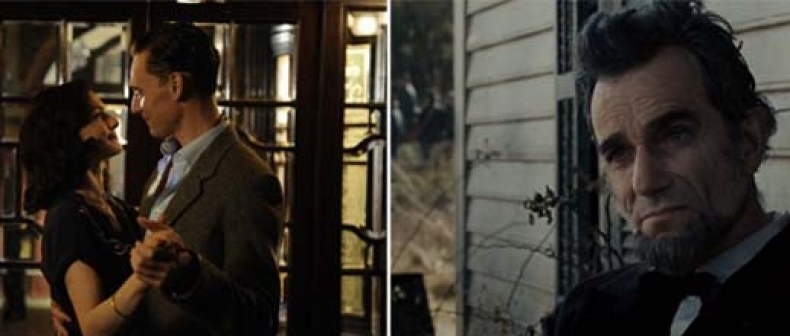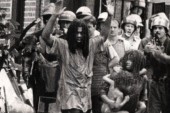
“The Deep Blue Sea,” “Lincoln,” “The Three Stooges,” “Bernie”
Of the many movies I saw this year, the ten that brought me the most pleasure and/or satisfaction:
Lincoln
The Deep Blue Sea
Compliance
Bernie
How to Die in Oregon
Zero Dark Thirty
The Grey
In the Family
Killing Them Softly
Smashed
To my mind, there weren’t a lot of overwhelmingly great films this year. Only Lincoln and The Deep Blue Sea scaled the full heights of what movies, at their best, can be. But there were quite a few very good pictures, more than I could fit into the above list. In fact, I could just as happily have included Oslo, August 31, Keep the Lights On, Killer Joe, Dredd, Sleeping Sickness, Goon, Stories We Tell, the ambitious but ultimately disappointing The Master, a sizeable number of documentaries (which I’ll get to later), and, believe it or not, The Three Stooges (more on that later, too.)
I can’t emphasize enough how much I loved and respected Steven Spielberg’s Lincoln, maybe the finest historical drama ever to come out of Hollywood. Tony Kushner’s thrillingly impassioned words, so clearly chosen to resonate in America’s current, depressing political climate, and Daniel Day-Lewis’s hugely empathic performance, so animated by his love for, and solidarity with, the man he portrays, are my idea of cultural heroism. The movie left me feeling hopeful both about humanity and about movies themselves.
Am I wrong, though, in thinking some critics have lost their initial enthusiasm for it? The movie topped only a few collective year-end lists, and many individual critics — even ones who wrote admiringly of it — left it off their personal lists completely. I’m guessing they found the movie, upon reflection, not sufficiently cinematic, too concerned with language and performance. Or maybe they simply felt it too conventional, especially when compared with the artfully cryptic Cannes darling Holy Motors. But let me ask this: is Holy Motors, a movie that refuses to take any responsibility for its meanings — which can be read practically any way one pleases — really such a brave choice for best-of-the-year? In a sense, it’s intellectually risk-free; one can’t be called out for liking it, because no one can really say what “it” is. The “conventional” Lincoln, meanwhile, risks tangible meanings and forces us to engage, on an unusually sophisticated level, with issues of real import.
Lincoln has also had to withstand being nit-picked to death in the wake of its huge, surprising box office success. The most compelling claim against it, that it endorses the “great man” theory of history and neglects the decades-long efforts of blacks to emancipate themselves, is legit, but I don’t think it’s reason to dismiss it. First of all, great stories require great characters, which makes the “great man” approach difficult to avoid. Secondly, this is a movie about Lincoln, not Frederick Douglass; it shouldn’t be faulted for what it isn’t. Do I wish it had stronger black characters in it? Yes. But if the choice is between a largely white movie that dignifies black history or a largely black movie that degrades black history — ie. Django Unchained — I’ll take the former.
Lincoln was pretty much the only big studio film I loved this year; the rest of my top ten came from outside the system. Killing Them Softly and Zero Dark Thirty (which I’ll be writing about next week) both owe their existence to rich benefactor Megan Ellison and her new Annapurna Pictures (as does The Master); The Grey was financed by the AMC and Regal theatrical chains; How to Die in Oregon was made for HBO (but got a theatrical release in Toronto thanks to The Projection Booth); and all the others were financed independently and very much on the cheap. Nevertheless, I was heartened to see Hollywood make some small effort at catering to adult moviegoers, even if only begrudgingly. Beyond all the usual fantasy and genre fare, the studios offered up Magic Mike, Argo, Flight, and Silver Linings Playbook. I wasn’t crazy for any of those films, and I had no love whatsoever for Argo (which turned out to be a fantasy film of a different kind), but they at least demonstrated sincere effort, which is all one can really ask for. (You can hardly demand greatness of every film, but you can, and should, demand sincerity.) In any case, they are all the sort of picture I wish Hollywood made more often. The fact that each of them killed it at the box office certainly helps their case.
As for this year’s documentary crop, there were enough good titles to fill a top ten all on their own. Many debuted at Hot Docs: The Queen of Versailles, Detropia, Tchoupitoulas, The Invisible War, The Imposter, Searching for Sugar Man. I didn’t catch up with that last film until about a month ago. Though more than a little questionable as a work of investigative journalism, it’s superb as a cinematic portrait. The mystery-man at its centre, Sixto Rodriguez, really is/was a superb craftsman of pop music, and director Malik Bendjelloul evokes his past with funky stylistic brio. It’s easily the best-looking doc of the year. The Pruitt-Igoe Myth, another film I caught up with only recently, gets my vote as the year’s most thoughtful doc. It looks at the titular ’50s-era urban housing project in St. Louis, Missouri, which was such a disaster it had to be torn down in 1972, its name forever after used as short-hand for the failures of public housing in America. Director Chad Freidrichs, long obsessed with Pruitt-Igoe, offers up a highly compelling, astonishingly well-researched counter-argument to that narrative. He doesn’t exactly debunk the housing project’s reputation, but he corrects for many years of lazy analysis and offers up one of the most thorough, holistic examinations of urban planning ever attempted on film.
How to Survive a Plague is a very good addition to the field of AIDS documentaries; it begins, essentially, where Randy Shilts’s And The Band Played On left off, examining the growing pains of the Act-Up activist movement. Quite apart from its usefulness as an AIDS doc, it’s an excellent case-study in how any movement survives beyond its early fire-in-the-belly years. Finally, I’d like to call attention to a doc I stumbled upon via iTunes called Incendiary. It wasn’t released theatrically in Canada, but it’s so good it should have been. It examines the notorious 1991 Willingham case, in which a Texan man was sentenced to death for setting his house ablaze and killing his three sleeping daughters. All the evidence against him came from a forensic study of the scorched home, a study that gets thoroughly debunked over the course of the movie. Directors Steve Mims and Joe Bailey Jr. use the case to interrogate the whole science of fire investigation, making a pretty strong case that it’s no science at all, at least as currently practiced. Like so many true-crime docs, Incendiary takes its stylistic cues from Errol Morris’s The Thin Blue Line, but it’s maybe the only doc I’ve seen to live up to that comparison.
I feel a little sheepish that so many of my favourite films this year were American, but nothing I saw from Canada (save Stories We Tell, Goon, and parts of Monsieur Lazhar) and Britain (save The Deep Blue Sea) really knocked me out, and the foreign-language pickings — here in Toronto, anyway — were unusually tepid. The only foreign titles I admired at all, beyond Oslo, August 31 and Sleeping Sickness, were Rust and Bone and Footnote. (I should note, however, that I have yet to see Tabu, Barbara, A Royal Affair, This is Not a Film, or I Wish. I also haven’t seen Amour, but having detested all of Michael Haneke’s previous cinematic sour-balls I can’t really see myself loving this one. I’ll drag myself to it next week.) I actually didn’t dislike Holy Motors — I thought it a bit of goofy, if overpraised, fun. What’s best about it, I think, is that it’s a lark, that it isn’t intended to “mean” anything in particular. But then along come the pointy-headed types to inform us that it is, in fact, about “cinema,” specifically “the end of cinema.” (Isn’t it convenient how, when a film isn’t about much of anything, it can always be said to be about cinema?)
Many of the year’s most acclaimed foreign-language titles fell into the so-called “slow cinema” category: Once Upon a Time in Anatolia, The Turin Horse, etc. These movies, as swell as they sometimes are to look at, are deadly to sit through, and strictly for the art-as-penance crowd. For the sake of argument, let’s say these films actually offer the intellectual substance claimed for them; does this really justify all the relentless, willful tedium? Can’t intellectual substance come with a pulse? How can there even be intellectual substance without intellectual excitement, too? These movies are just the flip side of the coin to the worst, most hyper Hollywood productions. While the latter go to extremes of flashy sensory overload, the former go to extremes of arid ponderousness. Both are perverse and wisely avoided.
In closing, I’d like to fully alienate the film-studies types by offering my appreciation of the Farrelly Brothers’ latest cinematic opus, The Three Stooges. Like most moviegoers, I took a pass on the Stooges when it came out last spring, for a couple of reasons: 1) I’m not a fan of the original Stooges, 2) the trailers were a turn-off, and 3) I haven’t liked a Farrelly Brothers movie since There’s Something About Mary. Plus, there were the reviews, which were not kind. (“Moronic, stupid, idiotic entertainment for knuckleheads,” wrote the always charitable Peter Howell in the Toronto Star.) Catching up with it on DVD, however, I discovered a lot of very fine physical comedy, maybe the finest seen in a generation or more. I admit I found the movie almost creepy for the first 15 minutes, being so unused to seeing old-school slapstick in modern settings. But once I adjusted to what I was seeing, I began to enjoy myself wholeheartedly. Scene after scene, Chris Diamantopoulos, Sean Hayes, and Will Sasso pull off amazingly tight precision teamwork — watching them, you feel the same admiration you feel watching Chaplin, Keaton, and Lloyd. The material here is more lowbrow, sure, but it’s elegantly, gracefully lowbrow. A sequence in a nursery where the Stooges have a sort of squirt-gun fight with smiling, peeing babies is slapstick heaven and made me laugh harder than anything else this year. Now that flabby, semi-improvised riffing has became the standard in modern comedy via Judd Apatow, Seth McFarlane, and their ilk, it’s inspiring seeing a comedy work hard to get things just right. Add it to my top ten.
____
Scott MacDonald writes about cinema for Toronto Standard. You can follow him on Twitter at @scottpmac. He just started tweeting, so be gentle with him.
For more, follow us on Twitter @TorontoStandard and subscribe to our newsletter.














